With the rising cost of food and especially meat, many people are looking to closer to home to start raising their food. Backyard gardens are on the rise, and many people are starting to raise their own chickens for eggs. Meat chickens are one meat source that can be raised with minimal space (compared to say, a cow), convert feed efficiently, and can be processed at home with not much more than a sharp knife and a big pot.
This post will go through all of the steps to process a chicken at home.
Obviously, this is "graphic". If you aren't here to see how meat is made from a living animal, stop here and go check out another page. If you are anti-meat, stop here. If you can't stand the sight of anatomy, stop here. If you are not interested in how to process a chicken, stop here.
Ok.
Here's a shot of some of the meat birds. They are Cornish cross from Tractor Supply. They are seven weeks old, about the average age of all the chicken you get in a store. They are fed a 20% protein feed, no medication/antibiotics/hormones etc. These guys eat a LOT - in seven weeks, one dozen consumed about 200lbs of feed. They need a lot of water as well, close to the end, the dozen was consuming about 3 gallons a day.

First step not shown is getting your chicken. These guys are lazy and don't really run much. Pick them up and carry them to your designated slaughter spot. My spot is in the garage, with a rope hung from a gambrel pulley. The rope has a loop at the end, which I double around to make a noose of sorts that slides easily. I place the chicken's feet in the noose, and gently lower them to hang. Chickens will stop struggling and hang limp when upside down.

Find the jawbone of the chicken on one side. I use a scalpel, since it's the absolute sharpest blade I can get. You want your cut to be fast and quick, for minimal suffering to your chicken. Think about if you cut yourself on a very sharp knife - the pain doesn't start for a few minutes. In the chicken's case, in a few minutes, they will no longer be alive to have that pain. Cut deep enough to slice the artery, but not so deep you cut the trachea. I hold the scruff of the chicken to make the skin tight against the throat - not choking him, but snug.

I do one fast slice, and then lower the chicken into a contractor bag inside a bucket that has some heavy stuff in the bottom. This way, they are placed in the dark, they don't struggle, and they will pass away without panic. At the end of their life, when blood loss is nearly complete, muscle spasms will occur. The bucket keeps blood and whatnot contained.

I like to wash off the chicken to remove the blood and any dirt or poo. I find it makes the scalding not have the stink many complain about.

I keep my scald water on the stove, in an old water bath canning pot. I fill about 2/3 full, and then squirt in a good squirt or two of dish soap. This helps work into the feathers to loosen, and also keeps the smell down. I find the prewash with the hose helps heat transfer, so I lose less heat when scalding, which means less time to bring the water to temp. I aim for about 150 degrees, and check the water temp between birds.

I do one bird at a time. Put him in the water, and use a pair of tongs to swish him around. You want all parts of him to get nice and warm. The water temp is also not high enough to burn you, or cook the meat.

Scalding is done when you can grasp a wing feather and it pulls out, instead of pulling the bird out of the water. This is usually under a minute.

Start plucking. Feathers will slide right out, I like to go against the grain of the feathers to really get them out fast.

You can take feathers by the handful.

The wing feathers are little, just slide them off. I don't do a perfect pluck, just get the majority off. I will do a final go over when I wash the bird after gutting.

The feet have a skin on them, that can be peeled off. Feet make a good stock.

One cleaned off foot.

Find the joint at the hock, and place the blade there. You should be able to cut right through. If you are struggling, you are too high or too low.

Once the cut is nearly through, cut from the bottom of the joint.

The feet come off.

Cut along the back of the neck....

All the way from the base of the head to the back.

Slide the skin up on the base of the head, and cut the head off at the base.


Peel the skin off the neck and the "tubing", and then cut off the neck skin with the head attached. Leave the tubing to keep food from coming from the crop out.

Peel the tubing - esophagus and trachea - from the neck.

Turn the chicken over, and separate some of the skin off the breast. The crop is stuck to the skin and the breast meat. Work it off both, so there is a sack attached to the esophagus, and then the tubing going into the body.

Can see the lumpy crop with food in it here. I'm working it off the skin.

Completely separated crop. If you leave the esophagus intact, food and such won't come out. I like to feed my chickens a bit before slaughter, so there is stuff in the crop. You don't have to, but it can get tricky to initially peel it. With food in it, you can grab it and work it apart.

I'm pulling apart the crop and tubing, there are bits of meat/glands attached. Just peel them off. I have the neck bent to the side (left). Cut the tubing off as deep down as you can, but be careful not to slice the breast meat.

Put the bird back up again (breast down), and find a good spot to cut the neck off. I just use my scalpel - young Cornish birds don't have a lot of hard bone. I actually use a scalpel all the way through, no other knives.

I'm starting the cuts to gut the bird. They have pelvic bones, and I use these as a guide for my first cut. I cut toward the bone, so I can open the bird up without cutting the guts.

I make another cut on the other pelvic bone, so I have two slits, one on each side, and about 1" or so wide.

I work my fingers in carefully and use the knife to open up the two holes until I open the gut cavity. Once I have both holes open, I just connect them by cutting the skin.

Find the end intestine that comes out to the vent. Loosen it off the gut cavity.

Cut around that tube by cutting around the vent.

I usually cut the tail off here at this point.

Reach in and use your hand to slide around the gut cavity, loosening up and tearing off the thin membrane that holds everything to the body. Be fairly gentle, so you're not ripping into the guts.

Reach to the front, and grab the heart and just pull everything out.

The lungs also need to come out. They are wedged between the ribs sort of in the middle. They are the bright red parts in this picture. I use my finger and slide it between the ribs, and pry them out. There are special tools, but I find I can pop them out with my fingers fairly easily. You can also see the "beans" - they are the cream colored bean shapes.This is a young rooster.

All of the parts. The lungs are on the lower left. You can see the ridges where they sit in the ribs.

At this point, you can throw out all of the parts, but many bits are great for stock. To use the liver, you need to carefully remove the gallbladder. It's a greenish/blackish pod, and is stuck to the liver. Carefully cut it's base out and remove. If you rupture it, immediately remove and wash off the liver.

I'm holding the gizzard. This is the big and HARD thing in the gut cavity. It's hard to mistake it for anything else.

To prepare the gizzard, just cut in half...

Open it up....

And then peel the yellow membrane off.

Innard parts - top is lungs, then heart below them, liver to right of the heart, gizzard and then gallbladder next to it. At the bottom are the intestines. This was a boy rooster, so his cojones are on the top to the right of the lungs. These look like white beans, and are stuck to the back. If you have an older rooster, these can get big, over an inch long.

One last step is to remove the kidneys. I find the easiest is to "scramble" them with my finger, they are buried almost in the back bone. When I wash the bird, I'll flush the bits out with water.

Washing the bird I use this time to really clean up any stray feathers.
I use this time to really clean up any stray feathers.

Clean bird.

Finishing touches. I like to use the back skin to hold the legs together to keep it easy to pack him up. Just cut a hole in the skin, about 1" up from the edge. It only has to be about 2" wide.

Making the cut....

Tuck the legs into the skin hole to truss them up.

For extra fancy, flip the wings back to tuck them.

Trussed up and ready to pack!

You can use freezer bags. I love my Foodsaver, and these guys fit perfectly into the large rolls. I think they store better as well.

At this point, the bird should rest in the fridge. You don't want to cook them right away, you need to let nature do it's thing and let rigor pass. If you grab a leg and it's not moving easily, it's not ready to cook. I let them rest in the fridge for 2-3 days, and then put them in the freezer until I'm ready to cook them.
When doing this the first time, expect about an hour of work. You'll get faster over time, some folks can do everything in about 15 minutes or less per bird, and there are many tools (such as pluckers) that can really speed things up. However, this is just to show that you can process a chicken with no more than a pot and a sharp knife.
Back to How to Raise & Process Chickens for Meat - Tips, Information and Pictures
This post will go through all of the steps to process a chicken at home.
Obviously, this is "graphic". If you aren't here to see how meat is made from a living animal, stop here and go check out another page. If you are anti-meat, stop here. If you can't stand the sight of anatomy, stop here. If you are not interested in how to process a chicken, stop here.
Ok.
Here's a shot of some of the meat birds. They are Cornish cross from Tractor Supply. They are seven weeks old, about the average age of all the chicken you get in a store. They are fed a 20% protein feed, no medication/antibiotics/hormones etc. These guys eat a LOT - in seven weeks, one dozen consumed about 200lbs of feed. They need a lot of water as well, close to the end, the dozen was consuming about 3 gallons a day.

First step not shown is getting your chicken. These guys are lazy and don't really run much. Pick them up and carry them to your designated slaughter spot. My spot is in the garage, with a rope hung from a gambrel pulley. The rope has a loop at the end, which I double around to make a noose of sorts that slides easily. I place the chicken's feet in the noose, and gently lower them to hang. Chickens will stop struggling and hang limp when upside down.
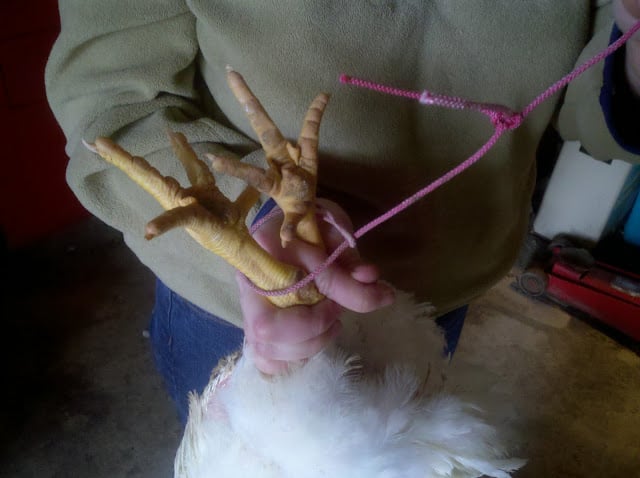
Find the jawbone of the chicken on one side. I use a scalpel, since it's the absolute sharpest blade I can get. You want your cut to be fast and quick, for minimal suffering to your chicken. Think about if you cut yourself on a very sharp knife - the pain doesn't start for a few minutes. In the chicken's case, in a few minutes, they will no longer be alive to have that pain. Cut deep enough to slice the artery, but not so deep you cut the trachea. I hold the scruff of the chicken to make the skin tight against the throat - not choking him, but snug.

I do one fast slice, and then lower the chicken into a contractor bag inside a bucket that has some heavy stuff in the bottom. This way, they are placed in the dark, they don't struggle, and they will pass away without panic. At the end of their life, when blood loss is nearly complete, muscle spasms will occur. The bucket keeps blood and whatnot contained.
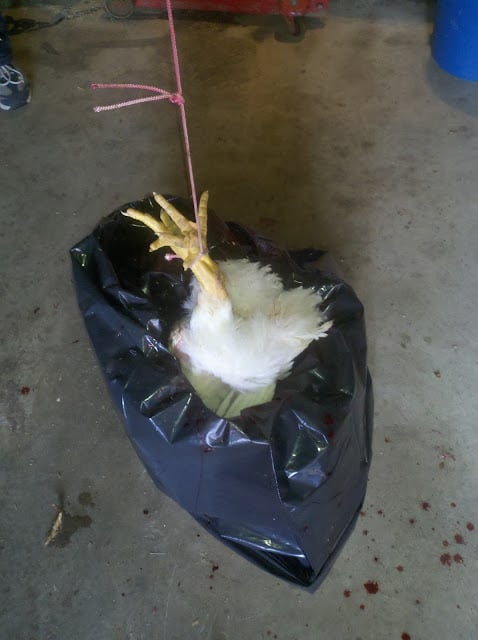
I like to wash off the chicken to remove the blood and any dirt or poo. I find it makes the scalding not have the stink many complain about.
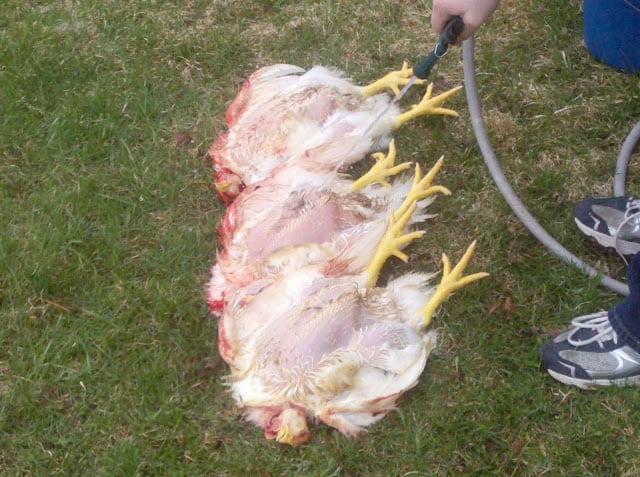
I keep my scald water on the stove, in an old water bath canning pot. I fill about 2/3 full, and then squirt in a good squirt or two of dish soap. This helps work into the feathers to loosen, and also keeps the smell down. I find the prewash with the hose helps heat transfer, so I lose less heat when scalding, which means less time to bring the water to temp. I aim for about 150 degrees, and check the water temp between birds.

I do one bird at a time. Put him in the water, and use a pair of tongs to swish him around. You want all parts of him to get nice and warm. The water temp is also not high enough to burn you, or cook the meat.

Scalding is done when you can grasp a wing feather and it pulls out, instead of pulling the bird out of the water. This is usually under a minute.

Start plucking. Feathers will slide right out, I like to go against the grain of the feathers to really get them out fast.

You can take feathers by the handful.

The wing feathers are little, just slide them off. I don't do a perfect pluck, just get the majority off. I will do a final go over when I wash the bird after gutting.

The feet have a skin on them, that can be peeled off. Feet make a good stock.

One cleaned off foot.

Find the joint at the hock, and place the blade there. You should be able to cut right through. If you are struggling, you are too high or too low.

Once the cut is nearly through, cut from the bottom of the joint.

The feet come off.
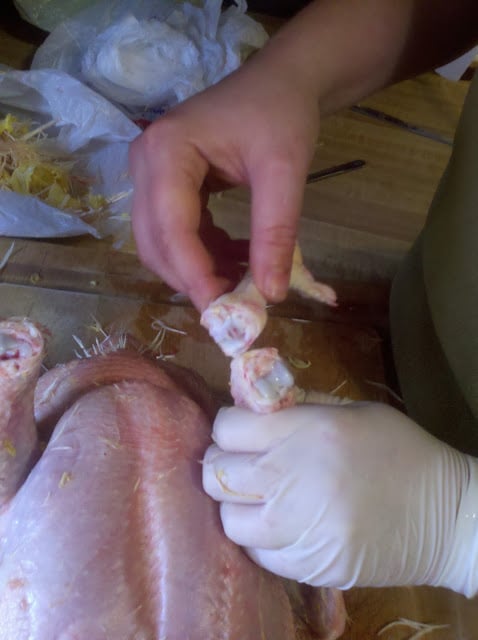
Cut along the back of the neck....

All the way from the base of the head to the back.

Slide the skin up on the base of the head, and cut the head off at the base.


Peel the skin off the neck and the "tubing", and then cut off the neck skin with the head attached. Leave the tubing to keep food from coming from the crop out.
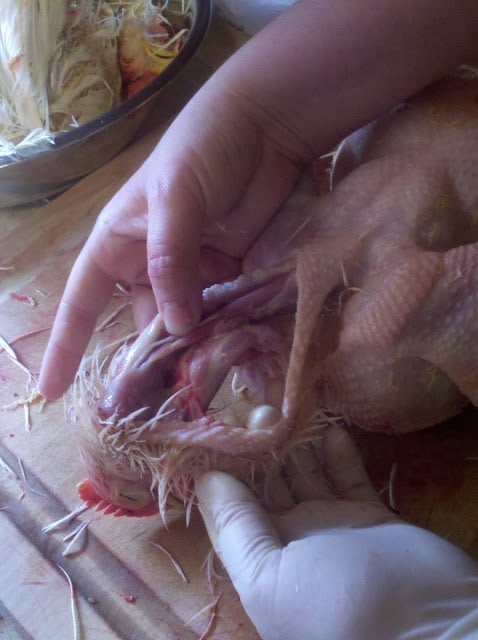
Peel the tubing - esophagus and trachea - from the neck.
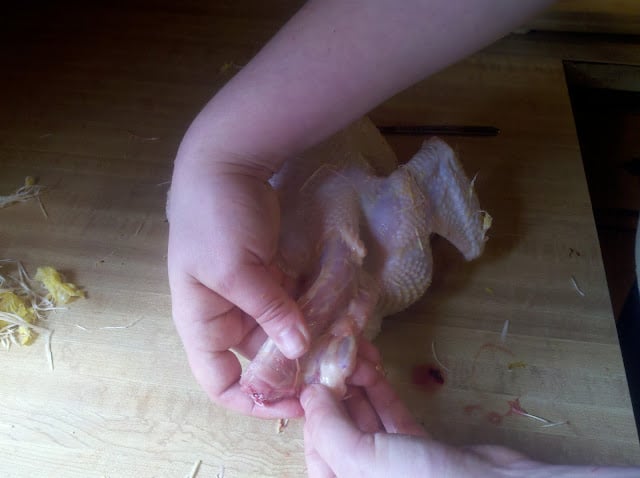
Turn the chicken over, and separate some of the skin off the breast. The crop is stuck to the skin and the breast meat. Work it off both, so there is a sack attached to the esophagus, and then the tubing going into the body.

Can see the lumpy crop with food in it here. I'm working it off the skin.

Completely separated crop. If you leave the esophagus intact, food and such won't come out. I like to feed my chickens a bit before slaughter, so there is stuff in the crop. You don't have to, but it can get tricky to initially peel it. With food in it, you can grab it and work it apart.

I'm pulling apart the crop and tubing, there are bits of meat/glands attached. Just peel them off. I have the neck bent to the side (left). Cut the tubing off as deep down as you can, but be careful not to slice the breast meat.
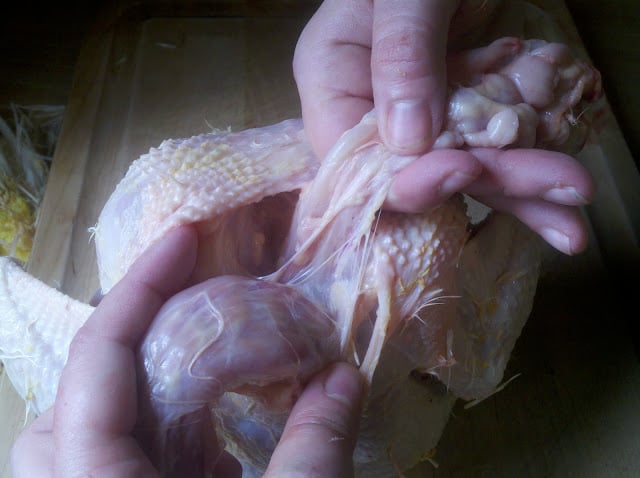
Put the bird back up again (breast down), and find a good spot to cut the neck off. I just use my scalpel - young Cornish birds don't have a lot of hard bone. I actually use a scalpel all the way through, no other knives.

I'm starting the cuts to gut the bird. They have pelvic bones, and I use these as a guide for my first cut. I cut toward the bone, so I can open the bird up without cutting the guts.

I make another cut on the other pelvic bone, so I have two slits, one on each side, and about 1" or so wide.

I work my fingers in carefully and use the knife to open up the two holes until I open the gut cavity. Once I have both holes open, I just connect them by cutting the skin.

Find the end intestine that comes out to the vent. Loosen it off the gut cavity.

Cut around that tube by cutting around the vent.

I usually cut the tail off here at this point.

Reach in and use your hand to slide around the gut cavity, loosening up and tearing off the thin membrane that holds everything to the body. Be fairly gentle, so you're not ripping into the guts.

Reach to the front, and grab the heart and just pull everything out.

The lungs also need to come out. They are wedged between the ribs sort of in the middle. They are the bright red parts in this picture. I use my finger and slide it between the ribs, and pry them out. There are special tools, but I find I can pop them out with my fingers fairly easily. You can also see the "beans" - they are the cream colored bean shapes.This is a young rooster.

All of the parts. The lungs are on the lower left. You can see the ridges where they sit in the ribs.

At this point, you can throw out all of the parts, but many bits are great for stock. To use the liver, you need to carefully remove the gallbladder. It's a greenish/blackish pod, and is stuck to the liver. Carefully cut it's base out and remove. If you rupture it, immediately remove and wash off the liver.

I'm holding the gizzard. This is the big and HARD thing in the gut cavity. It's hard to mistake it for anything else.
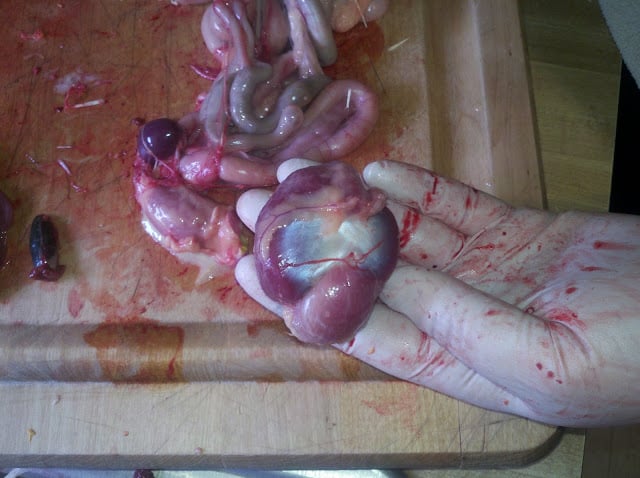
To prepare the gizzard, just cut in half...

Open it up....

And then peel the yellow membrane off.

Innard parts - top is lungs, then heart below them, liver to right of the heart, gizzard and then gallbladder next to it. At the bottom are the intestines. This was a boy rooster, so his cojones are on the top to the right of the lungs. These look like white beans, and are stuck to the back. If you have an older rooster, these can get big, over an inch long.

One last step is to remove the kidneys. I find the easiest is to "scramble" them with my finger, they are buried almost in the back bone. When I wash the bird, I'll flush the bits out with water.

Washing the bird
 I use this time to really clean up any stray feathers.
I use this time to really clean up any stray feathers.
Clean bird.
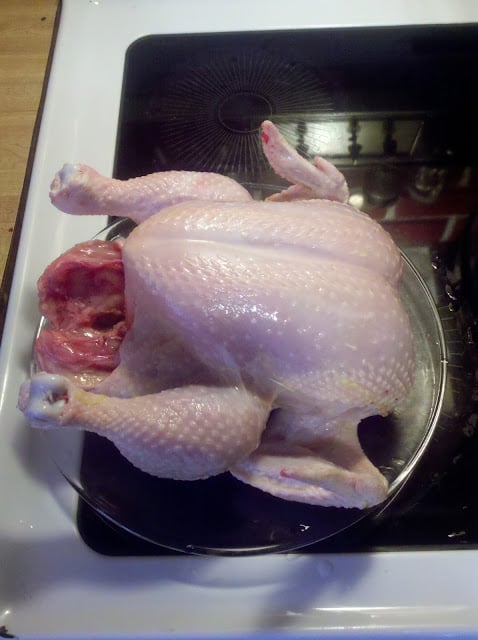
Finishing touches. I like to use the back skin to hold the legs together to keep it easy to pack him up. Just cut a hole in the skin, about 1" up from the edge. It only has to be about 2" wide.

Making the cut....

Tuck the legs into the skin hole to truss them up.

For extra fancy, flip the wings back to tuck them.
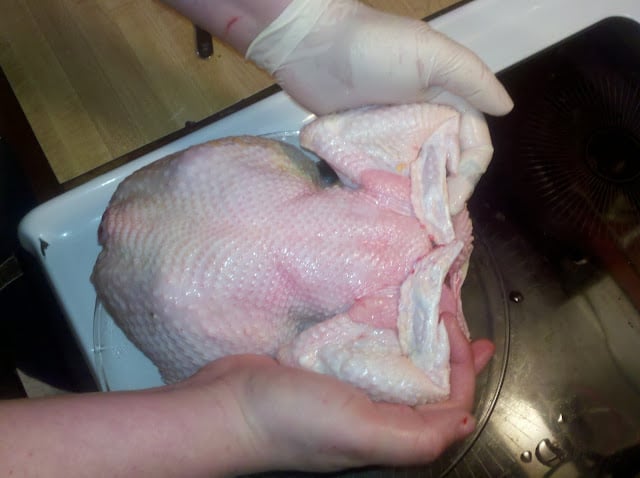
Trussed up and ready to pack!

You can use freezer bags. I love my Foodsaver, and these guys fit perfectly into the large rolls. I think they store better as well.

At this point, the bird should rest in the fridge. You don't want to cook them right away, you need to let nature do it's thing and let rigor pass. If you grab a leg and it's not moving easily, it's not ready to cook. I let them rest in the fridge for 2-3 days, and then put them in the freezer until I'm ready to cook them.
When doing this the first time, expect about an hour of work. You'll get faster over time, some folks can do everything in about 15 minutes or less per bird, and there are many tools (such as pluckers) that can really speed things up. However, this is just to show that you can process a chicken with no more than a pot and a sharp knife.
Back to How to Raise & Process Chickens for Meat - Tips, Information and Pictures



